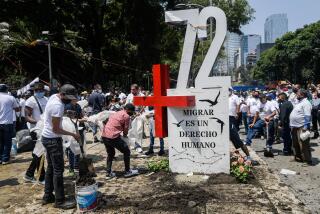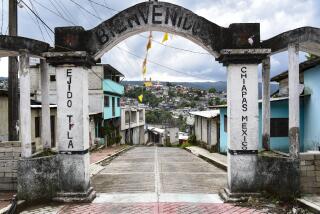Blood of the Homeless Darkens the Streets of Brazil’s Largest City
SAO PAULO, Brazil — The streets have never been a friendly place for Francisco Martins, who has lived on them for the last two years. But they never seemed lethal, either -- until now.
Sitting on a bench outside this city’s Roman Catholic cathedral, Martins stopped to reflect on a spate of killings of folks like him: penniless, homeless and virtually defenseless.
“I’m worried,” Martins, 58, said as he dunked a leaf of lettuce, his fingers dark with grime, in a cut-up water bottle for lunch. “But,” he added in a tone of weary acceptance, “what can I do?”
Since the middle of August, at least seven people living on the streets of South America’s largest city have been killed and many more injured in vicious nighttime assaults by attackers wielding crowbars and clubs.
The slayings have shaken residents accustomed to high levels of violence and have focused attention on the plight of Brazil’s homeless. Besides Sao Paulo, other major cities including Belo Horizonte and Recife have also recorded killings of vagrants and beggars since late August, crimes often as inexplicable as they are savage.
Here, outrage was added to shock and sorrow with the arrest last week of two military policemen accused of participating in the most egregious of the attacks, in which six people were bludgeoned to death within a 72-hour period in mid-August. Authorities now suspect that the two officers, as well as a third man, were members of a shadowy vigilante group linked to the drug trade.
The assaults occurred within a few blocks of one another in Sao Paulo’s historic district, near the Praca da Se, a shady square bustling with workers from nearby office buildings during the day but deserted at night except for the destitute men and women who sleep on its benches or beneath the trees.
In the early hours of Aug. 19, nine vagrants were discovered beaten or killed, some with their heads and faces bashed in, probably while they slept. More attacks followed in succeeding days, sowing terror among Sao Paulo’s 10,000 homeless. Shelters swelled to capacity as many sought refuge indoors.
By Aug. 22, the death toll had risen to six -- five men and one woman -- while several others lay wounded in hospitals, some in grave condition. Mayor Marta Suplicy declared three days of mourning, the dead were buried in publicly funded funerals, advocates of the homeless staged protests, and a society normally jaded by reports of violent crime demanded answers.
“There has always been violence against the homeless,” said Julio Lancelotti, a local priest who works with the destitute. “The difference now is that it was premeditated, organized and lethal. This is a pattern of violence we have never seen before.”
Human-rights activists compared the attacks to the 1993 massacre of eight homeless children and young adults outside the Candelaria church in downtown Rio de Janeiro, an event that has become a symbol of both the brutality of life on the street and of Brazil’s legions of corrupt cops, three of whom were found guilty of taking part in the assault.
Shortly after the Sao Paulo slayings in August, three vagrants in Belo Horizonte, the capital of Minas Gerais state, and two beggars in Recife, the capital of Pernambuco, were reported killed. But authorities say there does not appear to be any connection between those homicides and the ones in Sao Paulo.
Officials here pledged to track down the killers but also started bickering among themselves. The city accused the state of Sao Paulo of stinting on security, while state officials blamed the city for lacking enough shelters to house the needy.
At first, speculation about a motive for the attacks centered on “social cleansing” -- perhaps an effort by shopkeepers to get rid of loiterers. Skinhead groups also fell under suspicion.
But last week, police announced the arrest of the two military police officers and a third man, all of whom allegedly belonged to a clandestine security group that provided protection for drug traffickers.
Two of the victims are also suspected of ties to the drug trade, as couriers or users, and may have been the actual targets -- potential witnesses or informants the vigilante group wanted to silence. According to this theory, the other victims were beaten or killed to throw authorities off the assailants’ trail.
Despite the arrests, attacks have continued, possibly unrelated copycat crimes. In an ominous development, two witnesses -- also street dwellers -- to the first wave of assaults have disappeared, the daily O Estado de Sao Paulo reported Tuesday.
Fear ripples in the alleys and on the sidewalks where so many have died recently.
“The weakest or most vulnerable remain in the streets. Those who remain in the streets are afraid,” Lancelotti said. “They are sleeping less and drinking more.”
There is a sense of resignation as well. Sergio Augusto Silva, an out-of-work stonemason who has lived on the streets for three years, says he has no plans to enter one of Sao Paulo’s shelters because they are too crowded and impose strict rules.
He will continue to collect aluminum cans during the day to score a little spare change, and at night, he will continue to bed down on a smelly heap of blankets on a hard, unforgiving sidewalk south of the Praca da Se.
“If you die, you die,” said Silva, 50. “Anyone can die any day, any hour, any time.”
More to Read
Sign up for Essential California
The most important California stories and recommendations in your inbox every morning.
You may occasionally receive promotional content from the Los Angeles Times.











